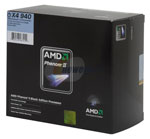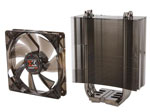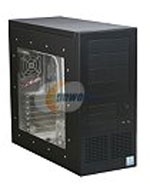AMD Performance Midrange
The introduction of Phenom II has made putting together an AMD performance midrange a joy again. While the Phenom was an honest competitor at the price points where AMD chose to compete, the poor overclocking of the AMD Phenom compared to Intel Core 2 Quad processors was always a nagging reality. Phenom II changes all that, and AMD in 45nm clothes is once again a screaming overclocker. We reached 3.9GHz in our testing for the Phenom II launch with a Phenom II 940 CPU. That same CPU is the starting point for our AMD performance midrange PC.
| AMD Performance Midrange PC | ||
| Hardware | Component | Price |
| Processor | Phenom II x4 940 Black Edition (3.0GHzx4 125W 4x512KB L2, 6MB L3) |
$215 |
| Cooling | Xigmatek Dark Knight-S1283V | $40 |
| Video | Sapphire Radeon HD 4890 1GB (After $20 Rebate) | $230 |
| Motherboard | Foxconn A79A-S AM2+/AM2 790FX | $140 |
| Memory | OCZ Reaper HPC 4GB (2x2GB) DDR2-1066 Dual-Channel Kit OCZ2RPR10664GK 5-5-5-18 (after $15 Rebate) | $55 |
| Hard Drive | Seagate Barracuda 7200.11 ST31000333AS 1TB | $90 |
| Optical Drive | LG BD/HD DVD / 16x DVD+/- RW GGC-H20LK | $99 |
| Audio | On Motherboard 8-channel | - |
| Case | Lian Li PC65B Black Aluminum Mid Tower | $100 |
| Power Supply | Silverstone ST70F 700W SLI/CrossFire 80 Plus Modular (after $25 Rebate) | $100 |
| Base System Total | $1069 | |
| Display | ASUS VW266H Black 25.5" 2ms(GTG) HDMI WUXGA LCD Monitor (1920x1200) (after $30 Rebate) | $320 |
| Speakers | Logitech G51 155W RMS 5.1 Speakers - Retail | $135 |
| Input | Microsoft CA9-00001 Black PS/2 Standard Keyboard and Optical USB/PS2 Mouse - OEM | $16 |
| Operating System | Microsoft Vista Home Premium OEM | $99 |
| Complete System Bottom Line | $1639 | |
| SSD (Optional) | OCZ Vertex OCZSSD2-1VTX60G 2.5" 60GB SATA II MLC Internal Solid state disk | $209 |
 |
For detailed information on the Phenom II, please read our AMD Phenom II launch article and the follow-up Phenom II X4 810 and X3 720. The Phenom II 940 at 3.0GHz is the fastest of the currently shipping AMD Phenom II processors, but that will likely change in a few weeks. The Phenom II is very similar in L2/L3 cache configuration to the Intel Core i7. Performance is also similar to comparably priced Intel midrange chips. As the first 45nm AMD processors the Phenom II also overclocks very well, finally approaching the overclocking levels enjoyed by Intel since the introduction of the Core 2 Duo.
 |
 |
The Phenom II is not the hot CPU you find in the Core i7, but it still benefits from third party cooling - particularly if you plan to overclock. We paired the Phenom II 940 with the Xigmatek Dark Knight, which performed well in the lab. At $40 the Xigmatek is also an excellent cooling value.
 |
Since the Phenom II 940 does not support DDR3, our DDR2+ motherboard was populated with a 4GB kit of OCZ Reaper HPC DDR2-1066. This memory is rated at a fast 5-5-5 at DDR2-1066 and it performs at faster timings and lower voltages at slower speeds. Whether you use it as a stock DDR2-1066 memory or overclock it to its limits, this OCZ memory should provide the headroom you need to bring out the best in this system.
 |
The case for the Phenom II performance midrange system is the well-regarded Lian Li black all aluminum case. This Lian Li case has a reputation for exceptional quiet with its four 80mm fans with a fan speed controller and the excellent heat dissipation you expect from an all aluminum case. What is unique is the $40 savings on this case through the month of April, which reduces the cost to $100. There is even a side window for those who like a view of their working system.
Other components in the AMD performance midrange system are the same used in the Intel performance midrange. You can find descriptions and thumbnail images of those components on the previous page.










73 Comments
View All Comments
RadnorHarkonnen - Wednesday, April 8, 2009 - link
Don't be Pedantic. Chill Out mates.I have a X2 4800+ OCed to 3Ghz. I game on it, i have a small file server on it, an exchange server always rolling, I GIMP some fotos, use sum torrentz, test like things i have fun with on my VMware, the wife is always seeing a movie of some sort (Desperate housewives or sex in the city, or some crap like that) plugged via HDMI to my TV. And much more...
A bit of this, a bit of that.
I personally like his rig. I wouldn't buy one like his, but hey there are other priorities. Maybe in the summer ill buy another for crossfire.
Wineohe - Tuesday, April 7, 2009 - link
Hmm. Not sure I get 1TB Barracuda. Sometimes price isn't everything. I guess you gotta spread the love.Wesley Fink - Wednesday, April 8, 2009 - link
The Seagate is now quite reliable and fast. The speed is a true 7200rpm, and not a "green" 5200rpm. Cache is 32MB, and not 16MB like many competing drives.Warranty is reduced to 3 years from the previous 5 years, but warranty service and replacement is very easy directly with Seagate. Seagate still offers the Enterprise version of this drive with 5-year warranty for $140, but if truth be know it is the same drive with a longer warranty and a higher price to pay for the longer coverage.
You can pay more for the same features and specifications. As we have said many times, you are generally safe with an HD from the major players and you can shop on price as long as specs are the same. There are good WD choices as well.
MadMan007 - Wednesday, April 8, 2009 - link
Seriously? Did you just say it's a great drive based upon paper specs? Features and specifications do not equal real world performance. Seagate drives after the 7200.10s should not be recommended. Supposed reliability issue aside the firmware is heavily slanted toward reads and the drives perform middle of the pack overall when looking at a wide range of real world uses. I understand for an article like this there's a need to stick to a strict price point but anyone who wants a 7200RPM 1TB drive ought to look elsewhere (WD drives are great atm) or if they don't need the space they'd be better served by a 7200RPM 640GB WD drive.Wesley Fink - Wednesday, April 8, 2009 - link
We use both the recent Seagate and WD 1TB drives. Both have performed well in the labs.MadMan007 - Wednesday, April 8, 2009 - link
Then you aren't testing them well enough but that's ok I've never read Anandtech for HD reviews. Heck the last non-SSD review is almost a year old and that was the V-Raptor, before that there is a 1TB drive review which is thoroughly outdated. Obviously in fairlyland everyone has only SSDs by now, the SSD articles are intriguing but don't reflect what people actually buy for storage as your own guides show.MadMan007 - Wednesday, April 8, 2009 - link
Sorry the above reads more rantishly than I meant it. Anyway my point was that quoting a bunch of paper specs doesn't mean much.erple2 - Friday, April 10, 2009 - link
Some thing that seems to get lost a lot is the question for the normal user:"How much faster is this drive in the stuff I care about?"
Benchmarks are good, I suppose, but they're also ridiculously non-linear. a two fold increase in sequential read performance in HD Tach doesn't translate into a two fold reduction in windows boot up time (or application startup time).
Maybe they are linear, but only with extenuating circumstances - If I have an old drive that loads application X in 20 seconds, getting a more recent drive could reduce the load time by 2 seconds. Getting a drive that's "twice" as fast as the slower new drive may reduce the application loading time by twice the increase, not half the time - the app now loads in 16 seconds rather than 18 seconds.
I dunno. It seems that the more I look at "real world" scenarios (which I understand are very hard to quantify and benchmark - they're essentially wall clock timings), the difference between 2 drives of the same rotational speed are marginal. Heck, even the difference between a 7200RPM drive and a 10k drive seems awfully marginal.
How often do I copy a single huge (on the order of 1 gigabyte) file that's stored sequentially? I dunno. Most of my data is lots of files that are smaller than 10 MiB (music and pictures), with significant numbers that are in the < 1 MiB range (everything else that isn't MP3's or pictures).
Huh.. Now I sound like I'm ranting.
However, if Anandtech is using the drives all the time in their test systems (and they haven't failed), then I'd believe that they're at least reliable. They may not be faster than a couple of Raptors in Raid 0, but from what else I've read, that's a total waste of time and money for my usage patterns (which don't include running a heavily used database, or other server application).
marc1000 - Tuesday, April 7, 2009 - link
wow, while I read the article I lost the 1st comment spot.. hehewell, I read a lot of these guides here at AT, and should shay the components choices are generally good. too bad I live in a country other than USA or England, so I can never buy those parts with the "real" pricing, instead I always pay higher for newer parts... it's a joke for us.......
anyway, I would like to say to anyone interested that these new CPUs and GPUs are really terrific performers. Today I have a fairly simple Core2Duo e7200 (2.6ghz 3mb cache) paired with a Radeon HD3850 and 4GB RAM. I never could completely stress this simple system... even gaming, I can run almost all games at a very good quality (22" LCD monitor with 16x10res), except for CRYSIS of course (but I don't like it anyway).
ssj4Gogeta - Wednesday, April 8, 2009 - link
"too bad I live in a country other than USA or England, so I can never buy those parts with the "real" pricing, instead I always pay higher for newer parts"same here. :( Especially when a new graphics card is launched. The price is as high as 2x the price in the US.